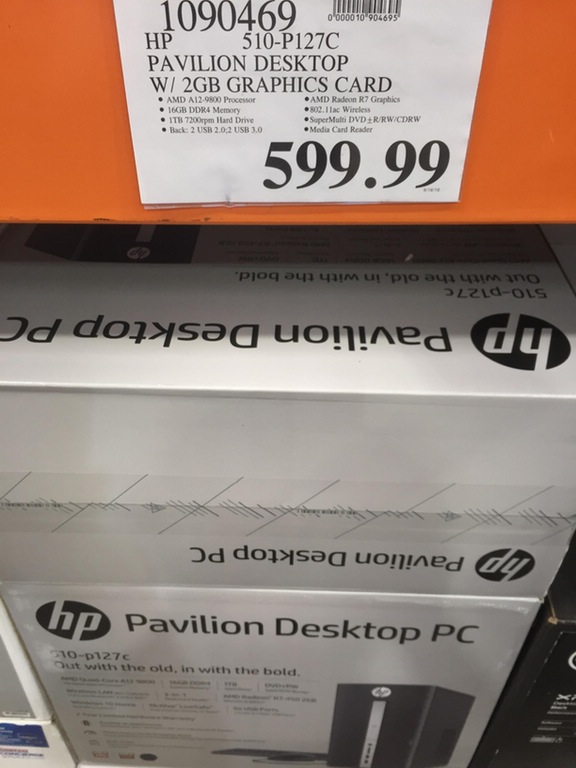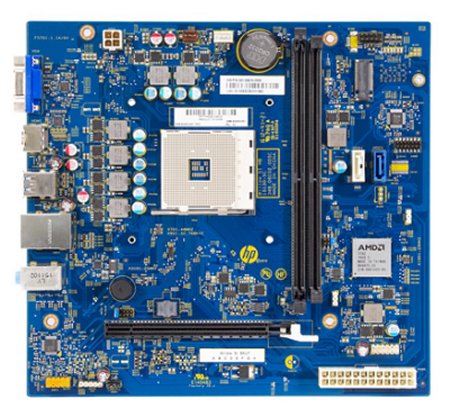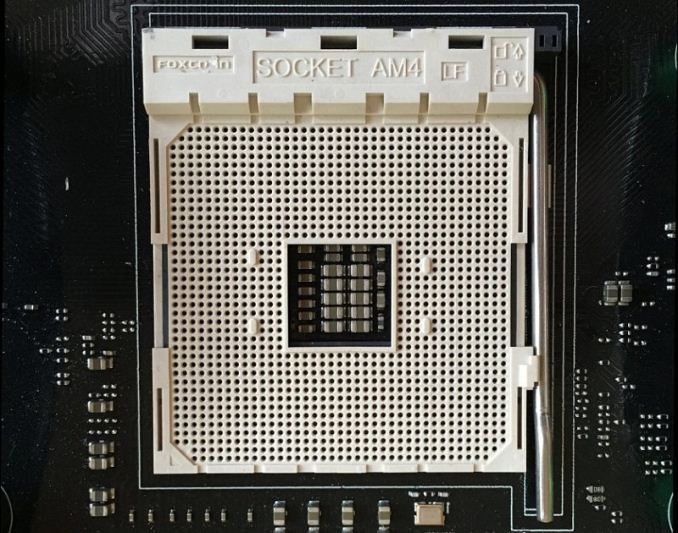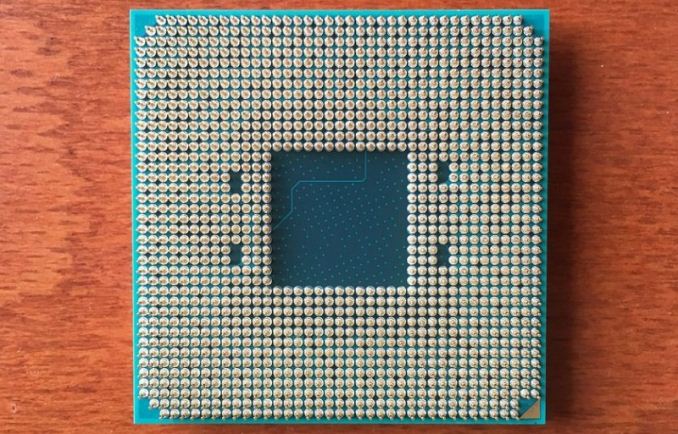AMD 7th Gen Bristol Ridge and AM4 Analysis: Up to A12-9800, B350/A320 Chipset, OEMs first, PIBs Later
by Ian Cutress on September 23, 2016 9:00 AM ESTMotherboards, Sockets, Pins and Things
As an OEM only launch, details about exact systems coming to market (and how they are designed) is providing slim pickings. With a normal retail launch, we have several motherboard manufacturers to dig our teeth into when asking questions, however our relationships with the major OEMs such as HP, Dell or Lenovo are quite different and typically more product focused and less engineering. We’ve not seen any real Bristol Ridge related announcements on OEM systems coming into the market, but some do exist. Reddit user starlightmica saw this HP Pavilion 510-p127c in Costco this week:
$600 gets an A12-9800, 16GB of DDR4, a 1TB mechanical drive, an additional R7 2GB graphics card, 802.11ac WiFi, a DVDRW drive, and a smattering of USB ports (but no USB 3.1, which is interesting).
We reached out to HP, as this system was listed online with the blurriest of motherboard images.
This is a ‘Willow’ motherboard, and we can see the AM4 socket in the middle. Contrary to previous platforms, it is worth noting that the socket mounting holes are significantly more ‘square’ than previous motherboard designs. However, when we discussed the images of the South Korean overclocker near the beginning of this article, it looked like he was using a standard AMD Wraith cooler, which might suggest that this square mounting hole situation might just be HP designing the motherboard.
The board clearly has six phases as part of the power delivery, plus an additional phase for the memory. I would assume that since the system has dual channel support, HP has developed the two memory slots as having dual channel capability, and the abundance of traces from the APU seems to suggest that as well.
To the right of the DRAM slots seems to be a PCIe x1 slot, which is where I assume the WiFi module is held. Below this slot are two of the system SATA ports, followed by what looks like a chipset with a big AMD logo on it and then the 24-pin power connector.
The motherboard has a full PCIe 3.0 x16 sized slot, although as we discussed before, this will be limited to PCIe 3.0 x8 due to the design of the processor. To the left of this is clearly a Realtek audio codec, and judging by the 2.1 support on the rear panel, this is most likely an ALC269 or some other low-end codec. It is hard to tell where the network controller is here without the high-resolution image, but just above and to the left of the speaker looks like a small IC which looks similar to Realtek’s low-end solutions. Typically Realtek offers a deal when audio+networking chips are used in the same system, so I suspect that is what is happening here. Above this are our USB ports, an HDMI output, and a VGA port which must be using a DP-to-VGA IC onboard.
We have closer up images of the socket, thanks to the Hungarian website hwsw:
This looks like the standard ZIF socket we’ve come to love/loathe from AMD (I doubt there’s a way that keeps everyone happy anyway), and others have counted 1331 holes which may/may not do things.
The rear of the CPU, also from hwsw, is what we would expect given the socket layout. It does mean that AMD is stuck at this level of connectivity, to anyone wishing for a quad-channel AMD platform suitable for consumers will have to wait until a future platform. It’s also worth noting that this looks like a similar size to when AMD CEO Lisa Su held up a Zen chip for the press back at the Zen announcements in August.
What Happens Now
Aside from spotting systems like the HP in Costco, no doubt a number of media outlets (us included) are trying to get hold of a number of the APUs for official reviews. As mentioned previously, that A12-9800 looks like an exciting all round part. We are working with AMD to secure the platform and the APUs for testing.
AMD has told us that Bristol Ridge APUs are designed to have price parity with the current Kaveri Refresh/Godavari models, however exact configurations of APUs and coolers, as well as a timeframe for the motherboard manufacturers to come out with their designs, is still to be decided.
I suspect that AMD will wait until closer to the Zen launch window to put Bristol Ridge on the shelves. Attacking the market with a new platform that goes from the high-end desktop through to all but the cheapest systems would mean a concerted effort to gain market share and recognition for catering to the performance needs of as many users as possible all at once. AMD has promised that Zen will trickle down the stack, however as we were told regarding their server and laptop plans later in 2017, that will mostly likely occur later in the year also.
If you’ve read through this piece, or merely skipped to the last page for the conclusions, here’s the take away from the Bristol Ridge for desktop launch:
- OEMs first, DIY builds later
- The A12 at 65W has better specifications than the best previous generation A10 at 95W
- Even at 65W, there is +30% frequency on the integrated graphics for the A12-9800
- The chipsets support USB 3.1 (10 Gbps) natively, but Type-C requires a small additional chip
- Bristol Ridge is more like an SoC, the chipset is entirely optional
- There are so many fun things you can do with PCIe and switches
- We expect the retail APUs to be price drop-ins for current APUs
- We’re trying to get these APUs for review. Stay tuned.





















122 Comments
View All Comments
Meteor2 - Saturday, September 24, 2016 - link
This. If HSA was *actually used* AMD performance would be fantastic.Shadowmaster625 - Sunday, September 25, 2016 - link
HSA is a pipe dream. Too much latency.patrickjp93 - Monday, September 26, 2016 - link
No it wouldn't. HSA requires code bloat which will damage cache friendliness in all cases where code cannot be offloaded to the iGPU. This is why Oracle, Fujitsu, IBM, Intel, and Nvidia all turned their nose up at it. HPX, OpenMP, and OpenACC kick the snot out of HSA as both a programming model and a hardware interface.Vayra - Friday, September 23, 2016 - link
I don't. Who cares about Apple in any comparison? They walled their garden. You go Apple or you go for something sensible.AbbieHoffman - Friday, November 11, 2016 - link
Why? Apple is just old outdated crap propped up by dumb hollywood trendies that don't know any better. Also Apple basically has slave labor and suicide nets around the buildings that house their employees. They won't even let them escape in death.romrunning - Friday, September 23, 2016 - link
Forget these older designs - let's get Zen released already, and work on a Zen mobile/ULV platform.euskalzabe - Friday, September 23, 2016 - link
Agreed... just release Zen already. I hope at least motherboards will be available by Xmas. Get the build ready, but a Zen CPU in jan/feb, drop it in and boom, new PC build.kn00tcn - Friday, September 23, 2016 - link
how is releasing mobos early any good? what happens if for whatever reason there are problems with old mobos when the high end cpus come (in a way similar to early ddr3 being higher voltage)Murloc - Saturday, September 24, 2016 - link
yeah it's just stupid to buy stuff to have it become old in your house before you can even use itKrysto - Friday, September 23, 2016 - link
Yeah, when can we expect Zen mobile APUs already?